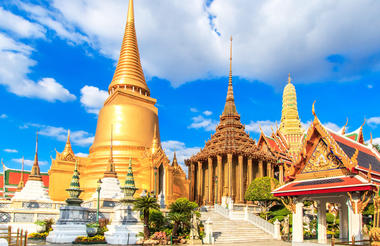Myanmar remains a land cloaked in mystery, where the path less travelled yields memories that linger for a lifetime. From the endless temple plains of Bagan, to the floating gardens and graceful fishermen of Inle Lake, to the pristine stretches of powdery sand along Ngapali, the country is a visual and cultural feast. Vast and diverse, roughly the size of France and England combined, Myanmar is home to more than 130 ethnic groups, each contributing to its extraordinary cultural mosaic. Stretching from snow-capped Himalayan peaks in the north to coral-fringed islands of the Andaman Sea in the south, Myanmar’s landscapes offer dramatic contrasts: fertile valleys, forested hills, serene rivers, and unspoilt coastlines. Ancient pagodas, royal palaces, and traditional villages pepper the terrain, offering a sense of timelessness and discovery. Whether seeking secluded beaches, cultural immersion, jungle adventures, or contemplative retreats among sacred temples, Myanmar presents an unrivalled opportunity to experience Southeast Asia in its purest and most authentic form—a country both enchanting and remarkably untouched.
With a population of over 5 million, Yangon, also known as Rangoon, was the capital of Myanmar up until the end of 2005. It remains the largest city, and is still the pivotal commercial hub of the country today. A visit to this magnificent city will allow you to take in the interesting mix of British, Burmese, Chinese and Indian cultures that mingle there. The skyline is an interesting contrast of decaying colonial architecture and modern high-rises, dominated by the golden glow of the Shwedagon Pagoda, an exquisite Buddhist temple that draws pilgrims from across the globe. Your time here would be well spent visiting the impressive array of temples, museums and markets that the city has to offer.
History Yangon in brief
European countries in a race to control trade routes had established trading posts in across South East Asia. East India Trading company controlled by the British had extended its operations to the Burmese coast and where trading with the Burmese kings. Three Anglo-Burmese wars flared up and in the second Anglo-Burmese war 1852 the British took over Southern Burma and made Rangoon its capital. The old name of Rangoon was Dagon. After third war in 1885 and ousting king Thibaw in Mandalay where the capital was located Rangoon became the capital for the whole country of Burma. Dr William Montgomerie sketched the new plan for the city and Lt Alexander Fraser from the Bengal Engineers implemented. Many architects were employed to fill in the city plan with schools, hospitals, parks, banks, shops and administrative buildings.
Fast forward… the colonial times are long gone, but in Yangon they have left behind a rich architectural heritage, of a type which many other capital cities of the region has been lost to “progress”. Yangon has the largest number of colonial buildings in the whole of Southeast Asia. Many colonial-era buildings that today host state institutions and authorities, such as government banks and the Port Authority, as well as the High Court and City Hall, are clustered in the downtown area. The Strand Hotel is there, too, built by the famous Sarkies Brothers in 1901, and today a sumptuous reminder of a bygone era.
Unlike many of its regional counterparts Yangon is also still first and foremost a green city, despite the battering it received from a cyclone in 2008. In the tranquil settings of Kandawgyi Lake and Inya Lake, and along its wide avenues, Yangon can still boast countless old trees and vegetation. A panoramic view of the city reveals its beauty – with the awe-inspiring Shwedagon Pagoda in its golden hue on one side, on a low hill, and on the other side the ancient Sule Pagoda and its encircling shops in the downtown area.



Thousands of temples, stupas and monuments in astounding shapes and sizes were built over two and a half centuries by the earliest Myanmar kings in the glorification of their religion. The monuments are packed in 40 km² (16 miles²) of land, rust colored plains flanked by the great Ayeyarwaddy River in heart of the country. Rival in scope and historical significance to the world heritage sites of Angkor Wat in Cambodia or Borobudur in Indonesia, Bagan is not to be missed. A visit here is undoubtedly one of the most memorable travel highlights in Myanmar.
The kings of Bagan
From the 11th to the 14th centuries, Bagan was the earliest unified seat of Buddhism in Myanmar. King Anawratha is credited as the founder in 1044 AD, using Buddhism as a tool to unite the people and sparking the royal building trend. Architects, artists, craftsmen and slaves were brought from nearby countries to create temples with walls as thick as a house, stupas covered in elaborate stone reliefs, and pagodas with intricate murals of the Buddha’s reincarnated lives.
The twelve kings following Anawratha would each try to outdo the last, the result being a spectacular legacy of religious monuments. Despite the tolls of weather and neglect, many structures have survived well to the current day. Mosaic artwork covers some buildings, gold leaf or carvings on others, and vines over crumbling stone facades on still more. Depending on how one defines and counts the structures, numbers range from 2,100 to 4,400 temples in the heart of the archaeological site. Lenient regulations mean visitors can still climb the staircases of the tallest stupas to enjoy views the temple-studded landscape in all its glory. Watching the sun illuminate the outlines of the ancient ruins in the mist of dawn or dusk is yet another breathtaking experience of Myanmar. It’s no surprise that Bagan remains one of the most fascinating archaeological sites in all of Southeast Asia. Bagan was once one of the most glorious Burmese kingdom with trading relations extending to the ancient empires of India, Ceylon and Khmer. Other Myanmar Kingdoms such as at Thaton in today’s southern Myanmar were overrun by Bagan, and their culture and manpower absorbed into the Bagan Kingdom. In the late 14th century, the Bagan Kingdom abruptly scattered to the winds, purportedly with the arrival of the Mongols under Ghengis Khan. Its monuments remain, however, and have defied the ravages of time and nature. The majestic vestiges of the kingdom are ranked by many today as one of the great wonders of the world.
Even the great Marco Polo made reference to Bagan in The Description of the World, the narrative of his two and a half decade long odyssey into the Orient and beyond: “The towers are built of fine stone, and one has been covered with gold a finger thick, so that the tower appears to be of solid gold. Another is covered with silver in a similar manner and appears to be made of solid silver…They make one of the finest sights in the world, being exquisitely finished, splendid and costly. When illuminated by the sun they are especially brilliant and can be seen from the great distance”.



The last royal capital of Myanmar. Mention of the word “Mandalay” conjures up sentiments of romance and tragedy, as immortalized in the literary gifts of George Orwell, Rudyard Kipling and Somerset Maugham. The true saga of the last reigning monarch King Thibaw, however, is imbued with romance and tragedy as much as any literary account. Through a combination of deceit, manipulation and false hopes stirred by court advisors and his wife, the fitful reign of King Thibaw ended when the British took Upper Burma in 1885. His family was exiled to India, where they lived in near poverty for the remainder of their lives. Before him, the struggles of the many ancient kings to gain control of the region were as complex and fantastical as a fairy tale.
With British rule, Mandalay’s streets were laid out on a grid system with the large, square palace compound of the former King Thibaw as its epicenter and surrounded by high, red walls and a moat. The effect is unlike any other city in Southeast Asia. With Myanmar’s highest concentration of monks, hundreds of monasteries, and legions of craftsmen, Mandalay is widely regarded as the religious and cultural heart of Myanmar. Among the most venerable pagodas are the Mahamuni Paya, now home to an ancient Buddha image from Rakhine State in western Myanmar, covered in gold leaf by devout Buddhists over many years; and Kuthodaw Paya, with 729 marble slabs bearing inscriptions of the entire Buddhist Tripitaka canon placed around the central stupa. According to legend, on a visit to Myanmar accompanied by his disciple Ananda, the Buddha climbed the 236 meter high Mandalay Hill overlooking the surrounding plains. Standing at the summit, he pointed with arm outstretched to where the Mandalay Palace stands today, and declared that a great city would be founded there after 2,400 years. That year corresponds to 1857 AD, when King Mindon ordered the move of the royal capital from Amarapura to a new city constructed at the foot of Mandalay Hill and bearing its name. Near the top of the hill, a standing Buddha image represents the prophecy.



Fondly known as 'the land of smiles', Thailand is commonly associated with gorgeous golden sand, palm-lined beaches, warm aquamarine waters, glorious temples and verdant jungle-clad mountains. Thailand is the primary travel hub of Southeast Asia, offering a diverse range attractions and activities to suit all tastes and budgets. Whether exploring the teeming metropolis of Bangkok, relaxing on the tropical beaches of the southern islands, scuba diving in the underwater wonderland off the coast, jungle trekking to hill tribe villages in the North, or discovering the ancient capitals, Thailand is filled with attractions to satisfy any interest.
Chiang Mai, the storied “Rose of the North,” stands as the cultural soul of the former Lanna Kingdom, where centuries-old heritage blends effortlessly with contemporary refinement. Within the ancient moat and crumbling city gates lies a walkable old town filled with gleaming Lanna temples, fragrant food markets and curated boutiques showcasing northern craftsmanship. Nearby, the fashionable Nimmanhemin district offers chic cafés, design-led galleries and elegant cocktail lounges, while the Night Bazaar continues to draw visitors with its lively evening atmosphere. Chiang Mai is also a gateway to northern Thailand’s landscapes: forested mountains, rivers and national parks lie only moments away, with Doi Suthep’s revered hilltop temple providing sweeping views over the valley. Anchored by distinctive Lanna cuisine, world-class hotels and easy access to nature, Chiang Mai delivers a refined yet soulful northern Thai experience.



Doi Pha Hom Pok National Park, formerly known as Mar Fang National Park, is the northernmost national park in Thailand. Aside from boasting over five hundred kilometres of beautifully rugged mountainous terrain, covered in pine forests and deciduous plants, Doi Pha Hom Pok is famed for its spectacular geographical features; Pha Hom Pok mountain, which at over two thousand metres is the second tallest peak in Thailand; and the geyser, which at over thirty metres is the highest in the country. The park’s lush terrain offers famous trekking, climbing and four-wheel driving trails, as well as remarkable bird watching opportunities and a plethora of enchanting hot springs. After a day of exploring, travellers can meander through the souvenir store, or relax with a drink and a pond-side snack at the visitor centre.


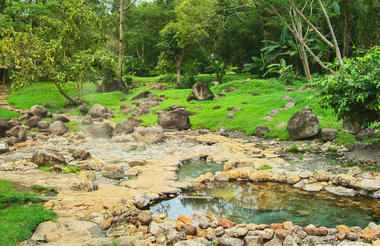
As previously described



Sukhothai is one of Thailand’s most sacred and historically significant sites, the former capital of the Sukhothai Kingdom which flourished during the 13th and 14th centuries and is often regarded as the cradle of Thai art, architecture and cultural identity. Though the original city was abandoned in the 16th century, its ruins have been carefully restored, and today the Sukhothai Historical Park—just 12 kilometres from New Sukhothai—is a UNESCO World Heritage Site celebrated for its serene Buddha statues, lotus-topped chedis, graceful prangs and atmospheric temple complexes set amid tranquil ponds and ancient trees. The surrounding area offers further avenues for exploration, including the Ramkhamhaeng National Museum and two scenic national parks that showcase the region’s natural beauty. Sukhothai stands as a deeply evocative window into early Siam, where spiritual grandeur and historical resonance remain beautifully intact.
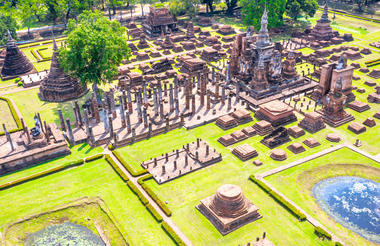


Kanchanaburi Town is the capital of Kanchanaburi Province in western Thailand, known for its easy access from Bangkok and a landscape shaped by rivers, forested hills and wartime history. The town serves as a comfortable base for exploring the region’s cultural sites and natural scenery. Key landmarks include the Bridge over the River Kwai, part of the historic Thai–Burma Railway, and the town’s two dedicated museums, which offer detailed insight into the railway’s construction and its wartime context. Travellers can experience a scenic two-hour train journey along the line, passing limestone cliffs, dense jungle and river bends. Nearby, Wat Tham Phu Wa features a cave complex with several shrines set within impressive rock formations. With its combination of accessible history, nature and local culture, Kanchanaburi provides a well-rounded and engaging destination for visitors.

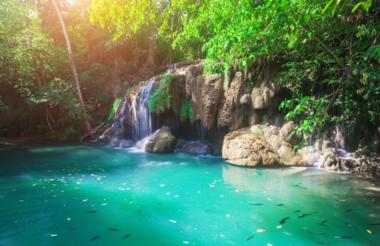
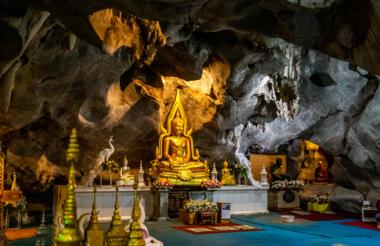
Bangkok, the “City of Angels,” is a spellbinding study in contrasts—one of the world’s most exhilarating capitals, forever reinventing itself while honouring centuries of royal heritage. Home to Thailand’s grand palaces and many of its most sacred temples, the city pairs deep tradition with a bold, forward-looking spirit. It offers some of Asia’s finest hotels, a constellation of glamorous rooftop bars with sweeping skyline views, and a culinary landscape that effortlessly spans award-winning restaurants and some of the most irresistible, affordable street food on earth. A paradise for shoppers, Bangkok delivers everything from high-end luxury malls to curated designer markets, and it has secured its place on the global touring circuit, drawing major international acts and hosting large-scale live performances throughout the year. Its legendary Muay Thai stadiums add a powerful dose of cultural intensity. Yet beyond the glittering high-rises lies a more intimate city: quiet canals, atmospheric Chinatown lanes lined with Michelin-plate eateries, and the tranquil sanctuary of Bang Krachao—Bangkok’s “Green Lung”—where shaded cycling paths and leafy gardens offer a welcome escape. Vibrant, creative and endlessly multifaceted, Bangkok remains one of the most compelling urban destinations in Asia.
